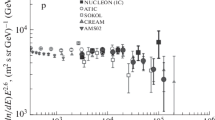Summary
The isotopic composition and the energy spectrum of singly charged particles of low energy were analysed using the emulsion stack which was launched on September 4, 1959 from Sioux Falls, S.D. (geomagnetic latitude ~ 53.5 °N) and floated for 8.8 hours under 2.0 g cm°-2 of residual atmosphere and materials. The grain densityvs. range method and the multiple scattering method were used for identification of particles. Fluxes of primary protons and deuterons at the top of the atmosphere are (0.22±0.02) protons m2 s1 sr1 MeV-1 for the kinetic energy range of 82 to 305 MeV for protons, and (0.020±0.008) deuterons m-2 s-1sr-1 (MeV/nucleon)-1 for 56 to 200 MeV/nucleon for deuterons, respectively. The differential energy spectrum of primary protons is given by E-(1.2±0.2). On the basis of the experimental results the possibility of the following origins is discussed: 1) galactic cosmic rays, 2) re-entrant albedo particles, 3) solar particles, and 4) particles from the inner Van Allen radiation belt. It seems to be probable that the particles observed are partly due to those leaked from the inner radiation belt by the distortion of the earth’s magnetic field, although low energy galactic cosmic rays and solar particles may be a part of them.
Riassunto
La composizione isotopica e lo spettro energetico di particelle di bassa energia a carica singola sono stati analizzati nel pacco di emulsioni lanciato il 4 Settembre 1959 da Sioux Falls, S.D. (lat. geomagnetica ~ 53.5° N), che restò per 8.8 ore a 2.0g/cm-2 di atmosfera residua e materiali. Il metodo della densità dei granuli riapetto al range e quello dello scattering multiplo furono usati per ridentificazione delle particelle. I flussi dei protoni e deutoni primari alla sommità dell’atmosfera sono, rispettivamente, (0.22±0.02) protoni m-2 s-1 sr-1 MeV-1 per energia cinetica da 82 a 305 MeV per i protoni, e (0.020± 0.008) deutoni m-2 s-1 sr-1 (MeV/nucleone)-1 per energia cinetica da 56 a 200MeV/nucleone per deutoni. Lo spettro differenziale dell’energia dei protoni primari è dato da E-(1.0±0.2. In base ai risultati sperimentali si discutono le possibilità delle seguenti origini: 1) raggi cosmici galattici, 2) particelle d’albedo rientranti, 3) particelle solari, e 4) particelle della fascia interna della radiazione di Van Allen. Sembra probabile che le particelle osservate provengano in parte da quelle sfuggite alla fascia interna di Van Allen per la distorsione del campo magnetico terrestre, per quanto possono farne parte anche raggi cosmici galattici di bassa energia e particelle solari.
Similar content being viewed by others
References
M. V. K. Appa Rao andP. J. Lavakare:Nuovo Cimento,26, 740 (1962).
M. V. K. Appa Rao:Phys. Rev.,123, 295 (1961).
M. V. K. Appa Rao andM. F. Kaplon:Journ. Phys. Soc. Japan,17,Suppl. A-III, 48 (1962).
M. V. K. Appa Rao:Journ. Geophys. Research,67, 1289 (1962).
B. Hilderbrand, F. W. O’Dell, M. M. Shapiro, B. Silberberg andB. Stiller:Bull. Am. Phys. Soc.,7, 311 (1962);Proc. Fifth Interamerican Seminar on Cosmic Rays, vol.1 (1962).
F. Folter andJ. H. Mulvey:Nuovo Cimento,27, 93 (1963).
H. Aizu:Thesis (1963).
W. R. Webber:Progress in Elementary Particles and Cosmic Ray Physics, vol 6, chapt. II (Amsterdam, 1962).
S. Biswas, C. E. Fichtel andD. E. Guss:Phys. Rev.,128, 2756 (1962);E. P. Ney andW. A. Sten:Journ. Geophys. Research,67, 2087 (1962);S. Biswas, C. E. Fichtel, D. E. Guss andC. J. Waddington :Journ. Geophys. Research,68, 3109 (1963).
R. Vogt:Phys. Rev.,125, 366 (1962).
P. Meyer andR. Vogt:Phys. Rev.,129, 2275 (1963).
M. Koshiba, E. Lohrmann, H. Aizu andE. Tamai:Phys. Rev.,131, 2692 (1963).
W. H. Barkas andD. M. Young: ÜCRL 2579 (Rev.), (1954).
C. Dilworth, S. J. Goldsack andL. Hirschfeld:Nuovn Cimento,11, 113 (1954).
V. L. Fitch, S. L. Meyer andP. A. Pitoué:Phys. Rev.,126, 1849 (1962).
J. J. Quenby andC. J. Wenk:Phil. Mag.,7, 1457 (1962).
H. Aizu, Y. Fujimoto, S. Hasegawa, M. Kosihba, I. Mito, J. Nisihmura and K. Yokoi:Prog. Theor. Phys. Suppl. No. 16, 54 (1960).
E. Belmont andJ. M. Miller:Phys. Rev.,95, 1554 (1954).
C. G. Heininger andE. O. Wiig:Phys. Rev.,101, 1074 (1956).
G. Friedlander, J. M. Miller, R. Wolfgang, J. Hudis andE. Baker:Phys. Rev.,94, 727 (1954).
F. F. Chen, C. P. Leavitt andA. M. Shapiro:Phys. Rev.,99, 857 (1955).
R. W. Deutsch:Phys. Rev.,97, 1110 (1955).
W. H. Barkas andJ. K. Bowker:Phys. Rev.,87, 207 (1952).
W. H. Barkas:Phys. Rev.,89, 1 (1953).
L. Marquez:Phys. Rev.,86, 405 (1952).
M. G. K. Menon, H. Muirhead andO. Rochat:Phil. Mag.,41, 583 (1950).
E. M. Burbidge, G. R. Burbidge, W. A. Fowler andF. Hoyle:Rev. Mod. Phys.,29, 547 (1957).
E. C. Ray:Journ. Geophys. Research,67, 3289 (1962).
U. Camerini, P. H. Fowler, W. O. Lock andH. Muirhead:Phil. Mag.,41, 413 (1950).
U. Camerini, J. H. Davis, P. H. Fowler, C. Franzinetti, J. Muirhead, W. O. Lock, D. H. Perkins andG. Yekutieli:Phil. Mag.,42, 1241 (1951).
D. A. Bryant, G. H. Ludwig and F. B. McDonald:Proc. Fifth Interamerican Seminar on Cosmic Rays, vol.1 (1962).
E. L. Chupp andK. W. Williams:Journ. Phys. Soc. Japan,17,Suppl. A-II, 281 (1962).
T. D. Kinman:Monthly Notices Roy. Astron. Soc.,116, 77 (1956).
S. Biswas, C. E. Fichtel andD. E. Guss:Phys. Rev.,128, 2756 (1962);E. P. Net andW. A. Stein:Journ. Geophys. Research,67, 2087 (1962);H. Yagoda, R. Filz andK. Fukui:Phys. Rev. Lett.,6, 626 (1961).
E. L. Fireman, J. De Felice andD. Tilles:Phys. Rev.,123, 1935 (1962).
O. A. Schaeffer andJ. Zähringer:Phys. Rev. Lett.,8, 389 (1962).
S. C. Freden andR. S. White:Phys. Rev. Lett.,3, 9 (1959).
A. H. Armstrong, F. B. Harrison, H. H. Heckman andL. Rosen:Journ. Geophys. Research,66, 361 (1961).
H. H. Heckman andA. H. Armstrong:Journ. Geophys. Research,67, 1255 (1962).
J. E. Naugle andD. A. Kniffen:Phys. Rev. Lett.,7, 3 (1961).
Author information
Authors and Affiliations
Rights and permissions
About this article
Cite this article
Hasegawa, H., Nakagawa, S. & Tamai, E. Measurement of hydrogen nuclei in primary cosmic rays. Nuovo Cim 36, 18–34 (1965). https://doi.org/10.1007/BF02750657
Received:
Published:
Issue Date:
DOI: https://doi.org/10.1007/BF02750657



